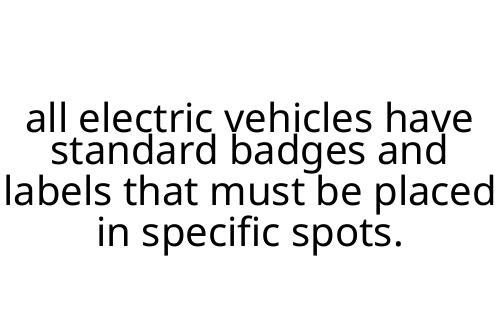all electric vehicles have standard badges and labels that must be placed in specific spots
If you’ve ever looked closely at electric vehicles (EVs), you might have noticed badges and labels on various parts of the car. This isn't just for branding. The reality is, all electric vehicles have standard badges and labels that must be placed in specific spots. These requirements serve clear purposes—safety, regulation, and ease of identification. Here’s what you should know about this crucial aspect of EVs.
Why Badges and Labels Matter on EVs
The badges and labels on EVs aren’t decorative. They exist to inform emergency responders, technicians, and even drivers themselves about the nature of the vehicle. For example, high-voltage components are marked to prevent accidental contact or improper service. This is especially important because EVs operate differently than gasoline cars.
In many regions, local, national, and international regulations mandate these identifiers. The reason is simple: someone working on or around the car needs to know instantly that it’s electric and where its key systems are located. Failing to place these labels accurately could lead to safety hazards or regulatory issues.
Required Badges and Label Placement
For all electric vehicles, the standards cover both badges (often for external identification) and labels (usually for internal warnings or informational purposes).
Common external badge locations:
- Rear of the vehicle: Usually on the trunk, tailgate, or rear bumper. This helps law enforcement, parking enforcement, and emergency responders quickly see that the car is electric.
- Sides or fenders: Some manufacturers add “Electric” or “EV” markers here as an extra precaution.
- Charging port cover: Identifies the port, and sometimes displays the voltage type or charging standard.
Internal label placement:
- Under the hood: Labels identify high-voltage components and provide warnings.
- Battery compartment: Often features clear and standardized warnings about voltage and proper handling.
- Door sills or inside the driver’s door jamb: Regulatory stickers here usually include certification details, vehicle weights, and the fact that the vehicle is fully electric.
Pros and Cons of This Standardization
Pros:
- Safety: The greatest benefit is to first responders and technicians. At the scene of a crash, knowing instantly that the vehicle contains high-voltage components can save lives.
- Consistency: Uniform placement makes training and response more efficient. Professionals know where to look, regardless of vehicle make.
- Legal Compliance: Manufacturers avoid fines and liability by following international standards.
Cons:
- Aesthetic limitations: Automakers can't always design badge and label placement purely for style.
- Potential confusion: If a badge is missing or incorrectly placed, it could lead to mistaken assumptions about the vehicle type.
Key Takeaways for Drivers and Shoppers
If you’re considering buying or servicing an EV, knowing that all electric vehicles have standard badges and labels that must be placed in specific spots is more than a technicality—it’s about safety and trust. Look for these markers when shopping, inspecting, or working on electric vehicles, and never ignore a missing or damaged label. Proper labeling is a sign that your EV meets global safety standards and is ready for the road.

